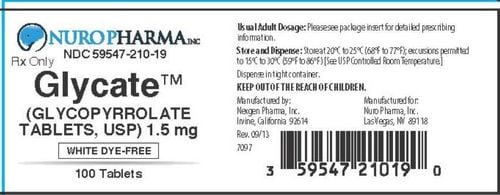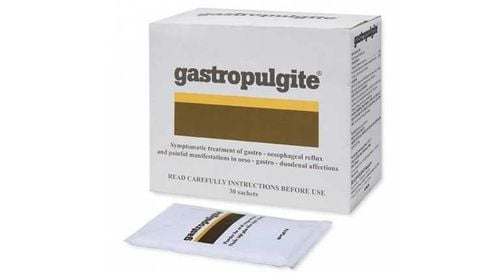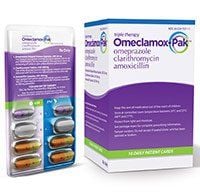This is an automatically translated article.
Pylomed is a drug used to treat stomach and duodenal diseases caused by HP bacteria. So more specifically, what disease does Pylomed treat and is Pylomed an antibiotic?
1. What is Pylomed?
Is Pylomed an antibiotic? Pylomed is a product of India Medley Pharmaceutical Company, the drug is prepared in the form of a Kit containing capsules and film-coated tablets. Each box of Pylomed contains 7 Kits, each Kit includes 2 tablets containing the antibiotic Tinidazol 500mg, 2 tablets containing the antibiotic Clarithromycin 250mg, 2 capsules containing the proton pump inhibitor Lansoprazole 30mg, registration number is VN-10397-10 .
2. What disease does Pylomed treat?
Pylomed is indicated for use in patients with gastric ulcer, duodenal ulcer, chronic gastritis, gastric ulcer - duodenal ulcer caused by Helicobacter Pylori bacteria.
Pharmacokinetic characteristics of Pylomed:
Active ingredient Lansoprazole is essentially a benzimidazole with inhibitory effect on gastric secretion. Lansoprazole's mechanism of action is to bind to H+/K+-ATPase in gastric parietal cells, thereby inactivating this enzyme system and blocking the final stage of HCl secretion by gastric parietal cells. Lansoprazole has the ability to inhibit gastric acid secretion at both basal and stimulated levels. Besides, this active ingredient can also inhibit H.pylori bacteria; The antibiotic Clarithromycin binds to the 50S ribosomal corpuscle of susceptible strains of bacteria, thereby inhibiting protein biosynthesis. The active ingredient Clarithromycin in Pylomed has good in vitro activity against H.pylori bacteria; Tinidazole antibiotic belongs to 5-Nitro Imidazol group with stronger potency and longer-lasting effect than Metronidazole. The active ingredient in this Pylomed drug is effective against H.pylori with its rapid bactericidal ability through the mechanism of blocking DNA synthesis and loss of the helix structure of existing DNA. Pharmacokinetic characteristics of Pylomed:
Lansoprazole is about 97% bound to plasma proteins, extensively metabolized in the liver and eliminated in both urine and bile; Clarithromycin is an antibiotic that penetrates the gastric mucosa and is approximately 80% bound to plasma proteins at therapeutic doses. Used at a dose of 500 mg, twice daily, the urinary excretion is about 30%. The active metabolite is 14-hydroxy clarithromycin, excreted mainly in the urine at a rate of about 10-15% of the dose. The remainder is excreted in the bile and excreted in the feces; Tinidazole in Pylomed is better tolerated and has a longer half-life (over 12 hours) than Metronidazole, so only a single dose should be used per day. Tinidazole is metabolized mainly in the liver through the catalysis of the CYP3A4 system, then excreted in the urine.
3. Dosage of the drug Pylomed
Pylomed is a drug that is taken orally. Each Kit is designed for a day of use, whereby when there is an indication to use the drug, the patient will take out 1 capsule containing Lansoprazole, 1 tablet of Tinidazol and 1 tablet of Clarithromycin, take all 3 tablets at the same time. in the morning. In the evening, the patient also uses the drug in the same order as above. The recommended duration of treatment with Pylomed is 7 days.
4. Side effects of the drug Pylomed
When using Pylomed, users may experience some unwanted effects (ADRs). However, the active ingredients of Pylomed are well tolerated, most of the common side effects are only mild, such as nausea, vomiting, diarrhea and abdominal pain. In rare cases, the patient may experience headache, skin rash, urticaria, taste changes (metallic taste in the mouth), glossitis, stomatitis, moderate leukopenia.
5. Contraindications of Pylomed
Some cases of not using Pylomed drug (contraindications) are people with a history of allergy or hypersensitivity to the ingredients of Pylomed drug.
6. Some Precautions When Using Pylomed
People with kidney or liver failure need to be especially careful when using Pylomed; Pseudomembranous colitis is seen in most cases of antibiotic use, including Clarithromycin in Pylomed. The severity of the disease can range from mild to life-threatening, so special attention should be paid to the diagnosis when a patient has diarrhea after taking antibiotics; Pregnancy: The active ingredients Lansoprazol, Tinidazol and Clarithromycin have not been studied in a controlled manner in pregnant women. Therefore, it is best not to appoint Pylomed to women during pregnancy; Lactation: The ability of the active ingredients of Pylomed to be excreted in breast milk is not known, so caution should be exercised when prescribing to lactating women.
7. Pylomed Drug Interactions
Theophylline in combination with the antibiotic Clarithromycin can lead to increased serum concentrations of Theophylline; Carbamazepine: Studies have shown that when a single dose of clarithromycin is administered concurrently with a carbamazepine, the blood concentration of carbamazepine may be increased; Concomitant use of Warfarin with the antibiotic Clarithromycin has the potential to increase the anticoagulant effect of Warfarin, which necessitates monitoring of prothrombin time (PT) in these cases; Digoxin will increase the effect when combined with Clarithromycin in Pylomed; Terfenadine in combination with a single dose of clarithromycin will lead to increased blood levels of Terfenadin, especially dangerous when patients already have cardiac abnormalities (such as arrhythmias, bradycardia, QT prolongation, ischemic cardiomyopathy). , congestive heart failure ) or electrolyte disturbances; Clarithromycin increases the serum concentration of Cyclosporin when used in combination, therefore the dose of Cyclosporin should be reduced to prevent nephrotoxicity. Simultaneously, the use of Clarithromycin in patients being treated with drugs metabolised by the cytochrome P450 system may increase blood levels of these drugs; Ketoconazole, Ampicillin, iron salts: Lansoprazole is a very strong and long-lasting inhibitor of gastric secretion. Therefore, interactions may occur that affect the absorption of these drugs when used concurrently; Alcohol: Drinking alcohol while taking Pylomed can cause an “antabuse” effect “like disulfiram”, so alcohol should be avoided while taking this medicine; Disulfiram: Combination with Pylomed may cause acute delirium and confusion. Pylomed is a medicine used to treat diseases of the stomach - duodenum caused by Helicobacter pylori. To ensure effective use and avoid side effects, patients need to strictly follow the instructions of the doctor or pharmacist.
Follow Vinmec International General Hospital website to get more health, nutrition and beauty information to protect the health of yourself and your loved ones in your family.
Please dial HOTLINE for more information or register for an appointment HERE. Download MyVinmec app to make appointments faster and to manage your bookings easily.













